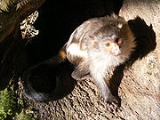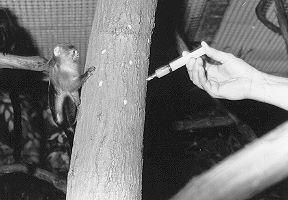
Black-tailed Marmoset
Encyclopedia
The black-tailed marmoset (Mico melanurus) is a species of New World monkey
from central South America
, where ranging from the south-central Amazon
in Brazil
, south through the Pantanal
and eastern Bolivia
, to the Chaco
in far northern Paraguay
. It is the southernmost member of the genus Mico
and the only where most of its range is outside the Amazon.
The black-tailed marmoset is dark brown with paler foreparts and a black tail. Unlike most of its relatives, it has a striking white or yellow-white stripe that extends down its thigh. Its ears are naked, flesh-colored and stand out from the fur. They reach a size of 18 to 28 cm and weigh from 300 to 400 g.
 Black-tailed marmosets are diurnal
Black-tailed marmosets are diurnal
and arboreal, using their claws to climb trees. Originally rain forest inhabitants, plantations have caused them to expanded them their range. They spend the night in tree hollows or in very close vegetation. They live together in small groups and mark their territory with scent glands, driving out intruders by shouting or by facial expressions (lowered brows and guarded lips).
The diet of the black-tailed marmoset predominantly consists of tree sap. To a lesser extent, they also eat bird eggs, fruits, insects, and small vertebrates.
After a 145 day gestation period, the female bears two (or rarely three) offspring. As is the case for many callitrichines, the father and the other group members take part with the raising of the offspring. Within six months the young are weaned, with full maturity coming at about two years of age.
New World monkey
New World monkeys are the five families of primates that are found in Central and South America: Callitrichidae, Cebidae, Aotidae, Pitheciidae, and Atelidae. The five families are ranked together as the Platyrrhini parvorder and the Ceboidea superfamily, which are essentially synonymous since...
from central South America
South America
South America is a continent situated in the Western Hemisphere, mostly in the Southern Hemisphere, with a relatively small portion in the Northern Hemisphere. The continent is also considered a subcontinent of the Americas. It is bordered on the west by the Pacific Ocean and on the north and east...
, where ranging from the south-central Amazon
Amazon Rainforest
The Amazon Rainforest , also known in English as Amazonia or the Amazon Jungle, is a moist broadleaf forest that covers most of the Amazon Basin of South America...
in Brazil
Brazil
Brazil , officially the Federative Republic of Brazil , is the largest country in South America. It is the world's fifth largest country, both by geographical area and by population with over 192 million people...
, south through the Pantanal
Pantanal
The Pantanal is a tropical wetland and one of the world's largest wetland of any kind. Most of it lies within the Brazilian state of Mato Grosso do Sul, but it extends into Mato Grosso and portions of Bolivia and Paraguay, sprawling over an area estimated at between and...
and eastern Bolivia
Bolivia
Bolivia officially known as Plurinational State of Bolivia , is a landlocked country in central South America. It is the poorest country in South America...
, to the Chaco
Gran Chaco
The Gran Chaco is a sparsely populated, hot and semi-arid lowland region of the Río de la Plata basin, divided among eastern Bolivia, Paraguay, northern Argentina and a portion of the Brazilian states of Mato Grosso and Mato Grosso do Sul, where it is connected with the Pantanal region...
in far northern Paraguay
Paraguay
Paraguay , officially the Republic of Paraguay , is a landlocked country in South America. It is bordered by Argentina to the south and southwest, Brazil to the east and northeast, and Bolivia to the northwest. Paraguay lies on both banks of the Paraguay River, which runs through the center of the...
. It is the southernmost member of the genus Mico
Mico (genus)
Mico is a genus of New World monkeys of the family Callitrichidae, the family containing marmosets and tamarins. The genus was formerly considered a subgenus of the genus Callithrix.-Taxonomy:...
and the only where most of its range is outside the Amazon.
The black-tailed marmoset is dark brown with paler foreparts and a black tail. Unlike most of its relatives, it has a striking white or yellow-white stripe that extends down its thigh. Its ears are naked, flesh-colored and stand out from the fur. They reach a size of 18 to 28 cm and weigh from 300 to 400 g.

Diurnal animal
Diurnality is a plant or animal behavior characterized by activity during the day and sleeping at night.-In animals:Animals that are not diurnal might be nocturnal or crepuscular . Many animal species are diurnal, including many mammals, insects, reptiles and birds...
and arboreal, using their claws to climb trees. Originally rain forest inhabitants, plantations have caused them to expanded them their range. They spend the night in tree hollows or in very close vegetation. They live together in small groups and mark their territory with scent glands, driving out intruders by shouting or by facial expressions (lowered brows and guarded lips).
The diet of the black-tailed marmoset predominantly consists of tree sap. To a lesser extent, they also eat bird eggs, fruits, insects, and small vertebrates.
After a 145 day gestation period, the female bears two (or rarely three) offspring. As is the case for many callitrichines, the father and the other group members take part with the raising of the offspring. Within six months the young are weaned, with full maturity coming at about two years of age.

